Temporal and Spatial Distribution of Cloud Water Content in Arid Region of Central Asia
Abstract
1. Introduction
2. Study Area and Method
2.1. Study Area
2.2. Method
3. Results
3.1. Spatial Distribution of WVC and Cloud Water Content
3.1.1. Spatial Distribution of Annual WVC
3.1.2. Spatial Composition of Atmospheric Water Vapor in Different Seasons
3.1.3. Spatial Distribution of the Annual Mean Content of CIWC and CLWC
3.1.4. Spatial Distribution of Seasonal Contents of CIWC and CLWC
3.2. Time Variation of Atmospheric WVC and Cloud Water Content
3.2.1. Annual Variation of WVC, CIWC and CLWC
3.2.2. Seasonal Variation of WVC, CIWC and CLWC
3.3. Trend Analysis of Atmospheric Water Vapor, CIWC and CLWC
4. Discussion
4.1. Analysis of the Relationship between WVC and Climate Change
4.2. Analysis of Cloud Water Resources in Arid Regions Based on Cloud Cover
5. Conclusions
Author Contributions
Funding
Institutional Review Board Statement
Informed Consent Statement
Data Availability Statement
Conflicts of Interest
References
- Guiot, J.; Cramer, W. Climate change: The 2015 Paris Agreement thresholds and Mediterranean basin ecosystems. Science 2016, 354, 465–468. [Google Scholar] [CrossRef] [PubMed]
- Zeng, S.K.; Yong, B. Evaluation of the GPM-based IMERG and GSMaP precipitation estimates over the Sichuan region. Acta Geogr. Sin. 2019, 74, 1305–1318. [Google Scholar]
- Li, X.; Guo, X.; Zhu, J. Climatic distribution features and trends of cloud water resources over China. Chin. J. Atmos. Sci. 2008, 32, 1094–1106. [Google Scholar]
- Donat, M.G.; Lowry, A.L.; Alexander, L.V.; O’Gorman, P.A.; Maher, N. More extreme pre-cipitation in the world’s dry and wet regions. Nat. Clim. Chang. 2016, 6, 508–513. [Google Scholar] [CrossRef]
- Fang, J.; Zhu, J.; Shi, Y. The responses of ecosystems to global warming. Sci. Bull. 2018, 63, 136–140. [Google Scholar] [CrossRef]
- Cao, L.; Yu, J.; Ge, Z. Water vapor content in the atmosphere and its variation trend over North China. Adv. Water Sci. 2005, 16, 439–443. [Google Scholar]
- Chen, Y.; Deng, J. Vertical Distribution of Ice Water Content in Clouds during Heavy Rains around Tianshan Mountain. Resour. Sci. 2013, 35, 655–664. [Google Scholar]
- Howard, K.; Howard, K.K. The new “Silk Road Economic Belt” as a threat to the sustainable management of Central Asia’s transboundary water resources. Environ. Earth Sci. 2016, 75, 976. [Google Scholar] [CrossRef]
- Chen, X. Retrieval and Analysis of Evapotranspiration in Central Areas of Asia; Meteorogical Press: Beijing, China, 2012. [Google Scholar]
- Chen, X.; Jiang, F.Q.; Wang, Y.J.; Li, Y.M.; Hu, R.J. Characteristics of the Eco-geographical Pattern in Arid Land of Central Asia. Arid. Zone Res. 2013, 30, 385–390. [Google Scholar]
- Heng, Z.; Fu, Y. Analysis of global cloud, water, cloud and ice climate distribution based on NCEP CFSR data. In Proceedings of the 28th Annual Meeting of China Meteorological Society-S4: Addressing Climate Change and Developing Low-Carbon Economy, Xiamen, China, 2 November 2011. [Google Scholar]
- Kawase, H.; Takeuchi, Y.; Sato, T.; Kimura, F. Precipitable Water Vapor around Orographically Induced Convergence Line. Sola 2006, 2, 25–28. [Google Scholar] [CrossRef][Green Version]
- Smith, B.L.; Yuter, S.E. Water Vapor Fluxes and Orographic Precipitation over Northern California Associated with a Landfalling Atmospheric River. Mon. Weather. Rev. 2010, 138, 74–100. [Google Scholar] [CrossRef]
- Giovannettone, J.P.; Barros, A.P. Probing Regional Orographic Controls of Precipitation and Cloudiness in the Central Andes Using Satellite Data. J. Hydrometeorol. 2009, 10, 167–182. [Google Scholar] [CrossRef]
- Qian, Z.; Wu, T.; Liang, X. Feature of Mean Vertical Circulation over the Qinghai-Xizang Plateau and Its Neighborhood. Chin. J. Atmos. Sci. 2001, 25, 444–454. [Google Scholar]
- Gaffen, D.J.; Elliott, W.P.; Robock, A. Relationships between tropospheric water vapor and surface temperature as observed by radiosondes. Geophys. Res. Lett. 2013, 19, 1839–1842. [Google Scholar] [CrossRef]
- Balsamo, G.; Albergel, C.; Beljaars, A.; Boussetta, S.; Brun, E.; Cloke, H.; Dee, D.; Dutra, E.; Muñoz-Sabateret, J.; Pappenberger, F.; et al. ERA-Interim/Land: A global land surface reanalysis data set. Hydrol. Earth Syst. Sci. 2015, 19, 389–407. [Google Scholar] [CrossRef]
- Hu, R. Physical Geography of the Tianshan Mountains in China; Beijing; China Environmental Science Press: Beijing, China, 2004. [Google Scholar]
- Balashova, Y.; Zhitomirskaya, O.; Semyonova, O. Climatologic Characterization of the Central Asian Republics; Hydrom-Eteorological Publishing: Leningrad, Russia, 2006. [Google Scholar]
- Li, G.; Huang, D.; Guo, J. Ground-Based Gps/Met; Science Press: Beijing, China, 2010; pp. 148–150. [Google Scholar]
- Rubel, F.; Kottek, M. Observed and projected climate shifts 1901–2100 depicted by world maps of the Köppen-Geiger climate classification. Meteorol. Z. 2010, 19, 135–141. [Google Scholar] [CrossRef]
- IPCC. 2022: Summary for Policymakers. In Climate Change 2022: Impacts, Adaptation, and Vulnerability. Contribution of Working Group II to the Sixth Assessment Report of the Intergovernmental Panel on Climate Change; Pörtner, H.-O., Roberts, D.C., Poloczanska, E.S., Mintenbeck, K., Tignor, M., Alegría, A., Craig, M., Langsdorf, S., Löschke, S., Möller, V., et al., Eds.; Cambridge University Press: Cambridge, UK, 2022; in press. [Google Scholar]
- Burrows, M.T.; Schoeman, D.S.; Buckley, L.B.; Moore, P.; Poloczanska, E.S.; Brander, K.M.; Brown, C.; Bruno, J.F.; Duarte, C.M.; Halpern, B.S.; et al. The pace of shifting climate in marine and terrestrial ecosystems. Science 2011, 334, 652–655. [Google Scholar] [CrossRef]
- Zhao, H.; Xu, Z.; Zhao, J.; Huang, W. A drought rarity and evapotranspiration-based index as a suitable agricultural drought indicator. Ecol. Indic. 2017, 82, 530–538. [Google Scholar] [CrossRef]
- Du, L.; Li, J. Analysis on Cloud and Vapor Flux in the Northeast of the Qinghai—Tibet Plateau during the Period from 2001 to 2011. Arid. Zone Res. 2012, 29, 862–869. [Google Scholar]
- Geiss, A.; Marchand, R.; Thompson, L. The Influence of Sea Surface Temperature Reemergence on Marine Stratiform Cloud. Geophys. Res. Lett. 2020, 47, e2020GL086957. [Google Scholar] [CrossRef]
- Chen, Y.H.; Huang, J.P.; Chen, C.H.; Zhang, Q.; Feng, J.D.; Jin, H.C.; Wang, T.H. Temporal and Spatial Distributions of Cloud Water Resources over Northwestern China. Plateau Meteorol. 2005, 24, 905–912. [Google Scholar]
- Wang, H.Q.; Chen, Y.H.; Peng, K.J. Study on Cloud Water Resources of Mountain Ranges in Xinjiang Base on Aqua Satellite Date. J. Nat. Resour. 2011, 26, 89–96. [Google Scholar]

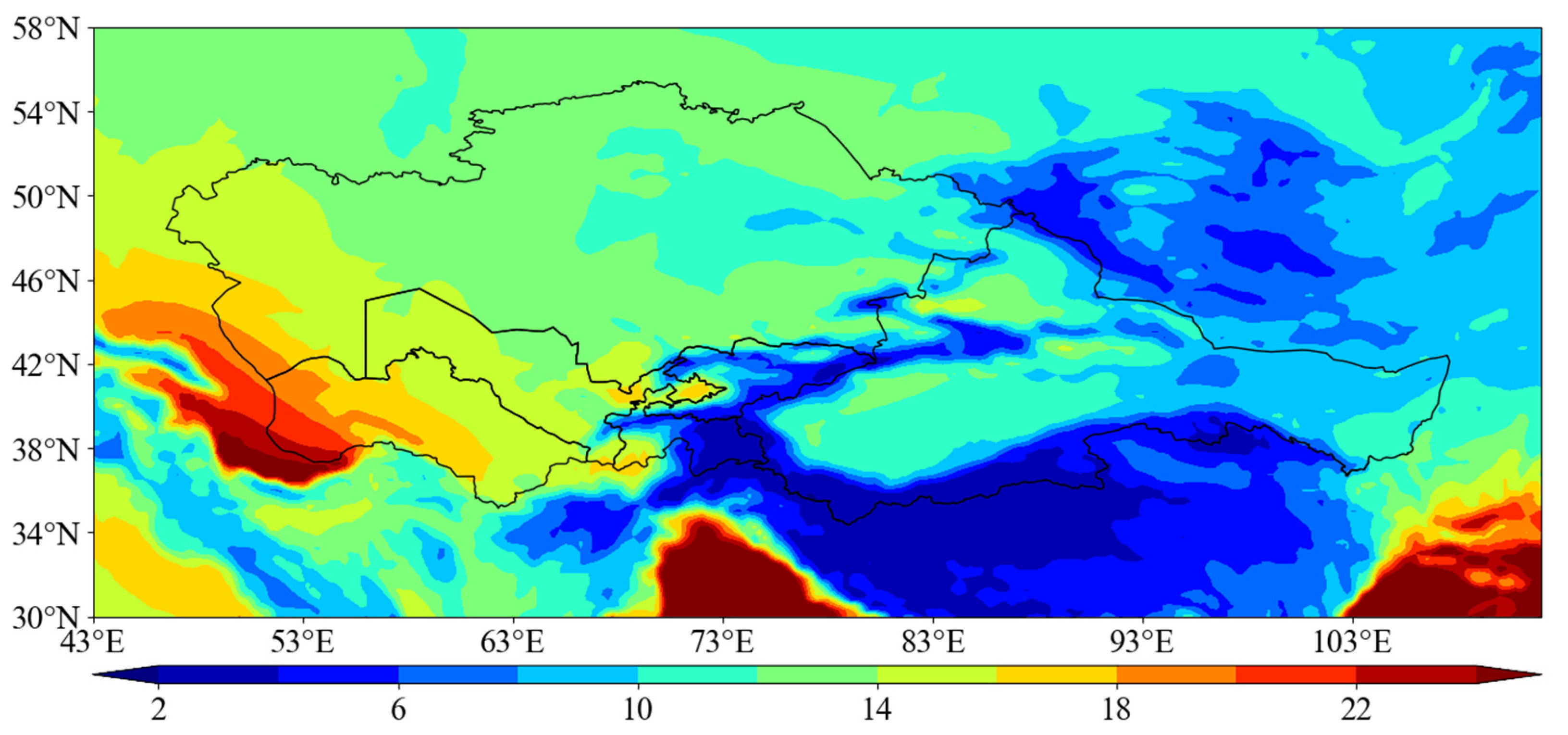


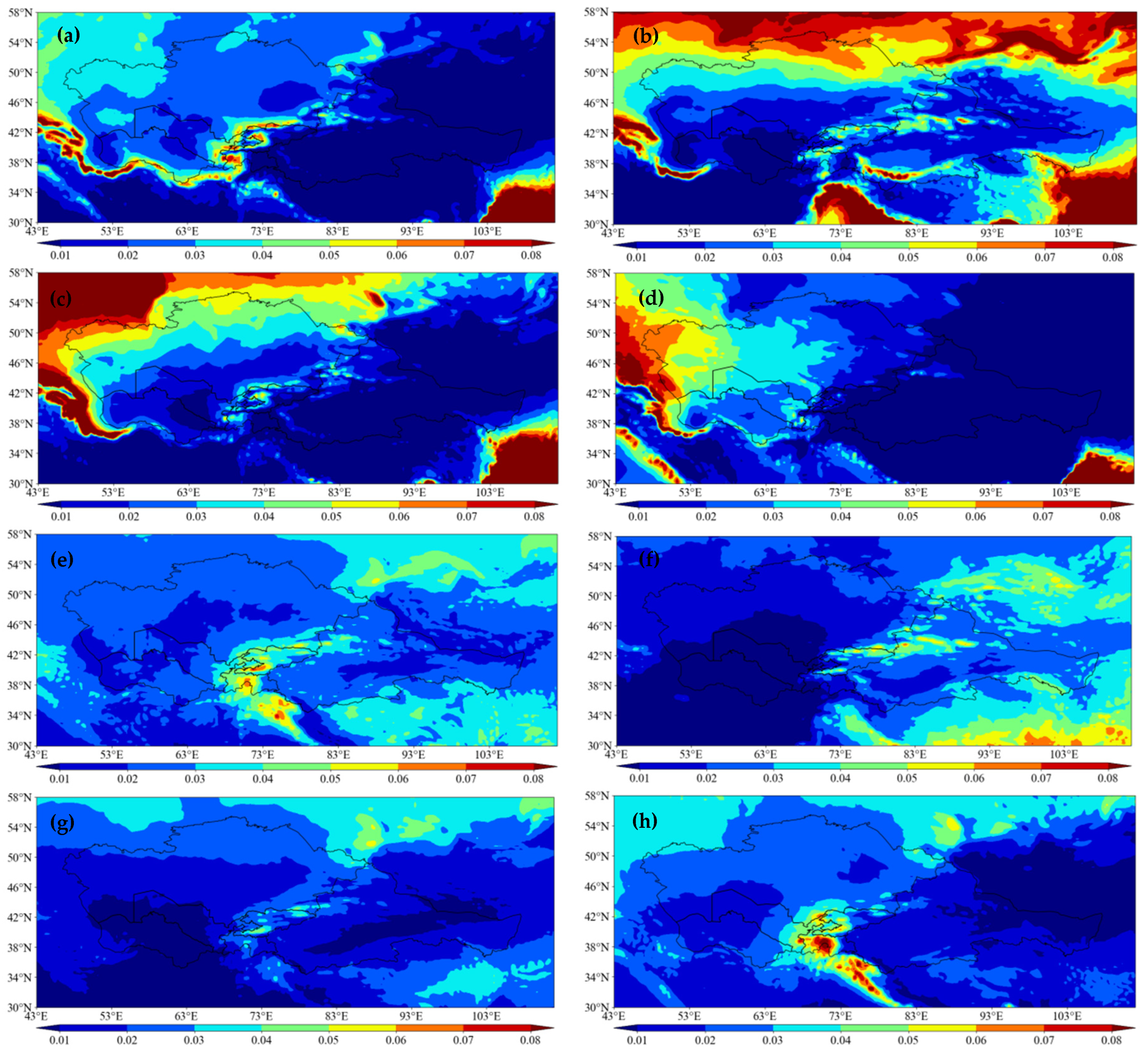
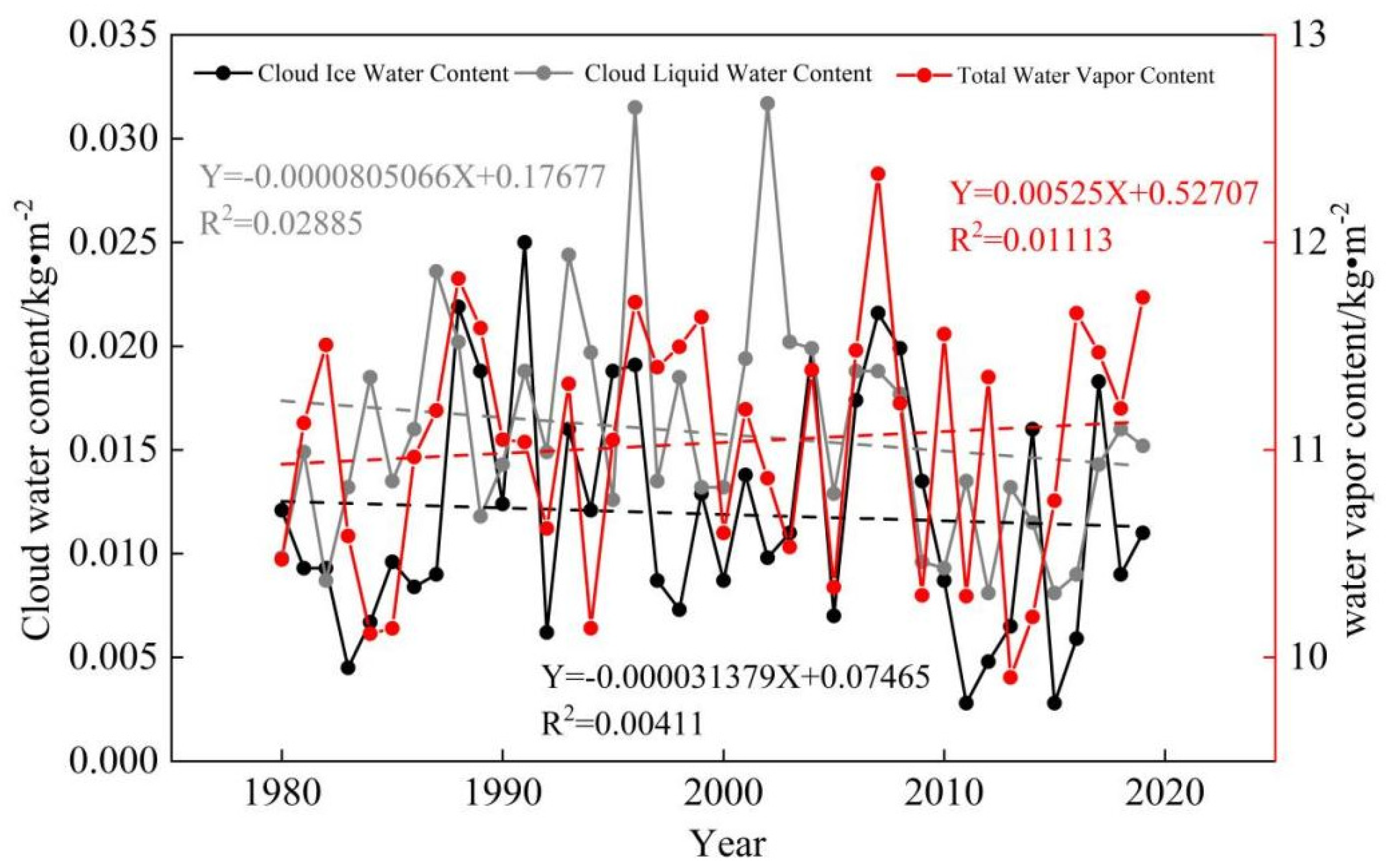
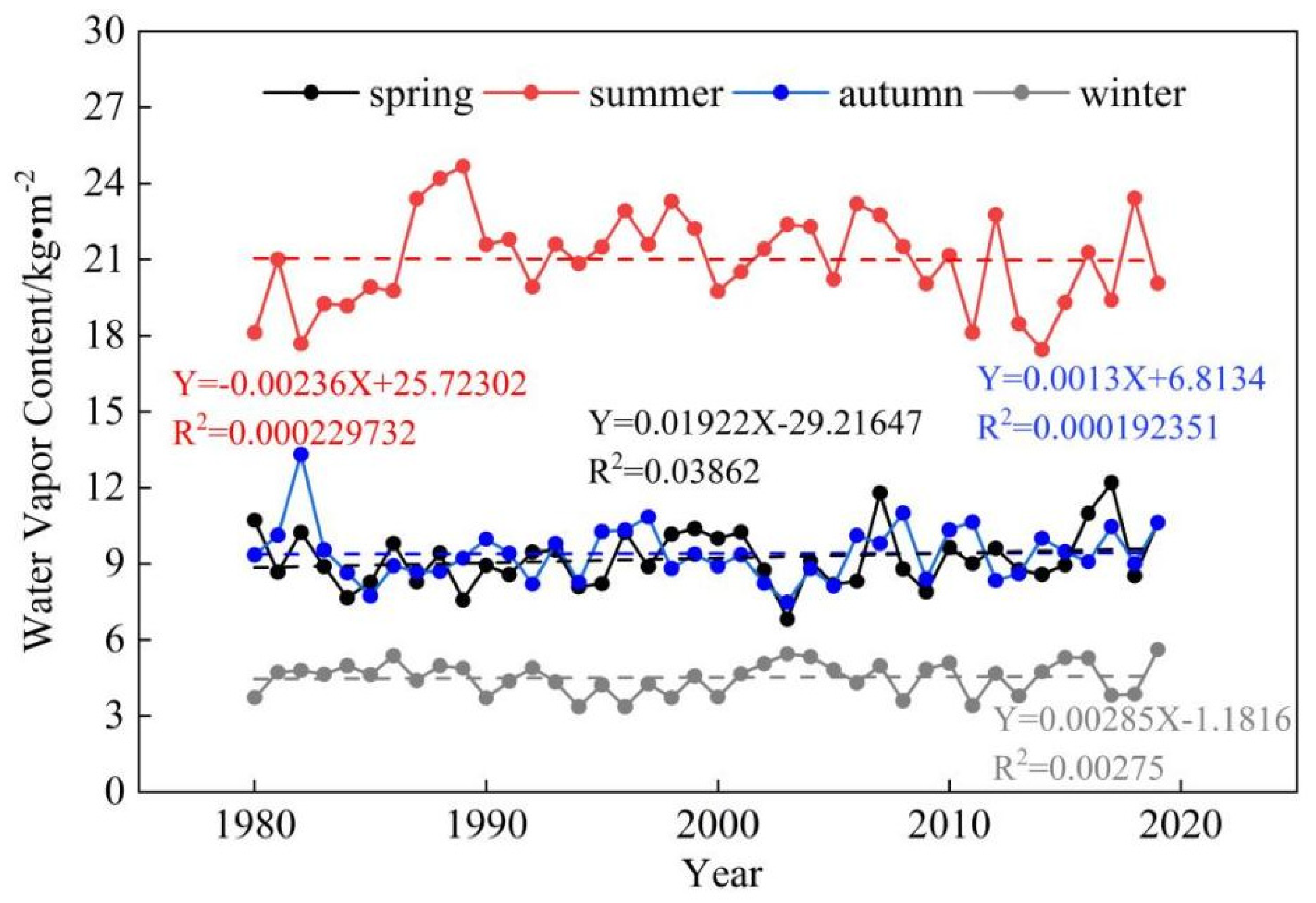


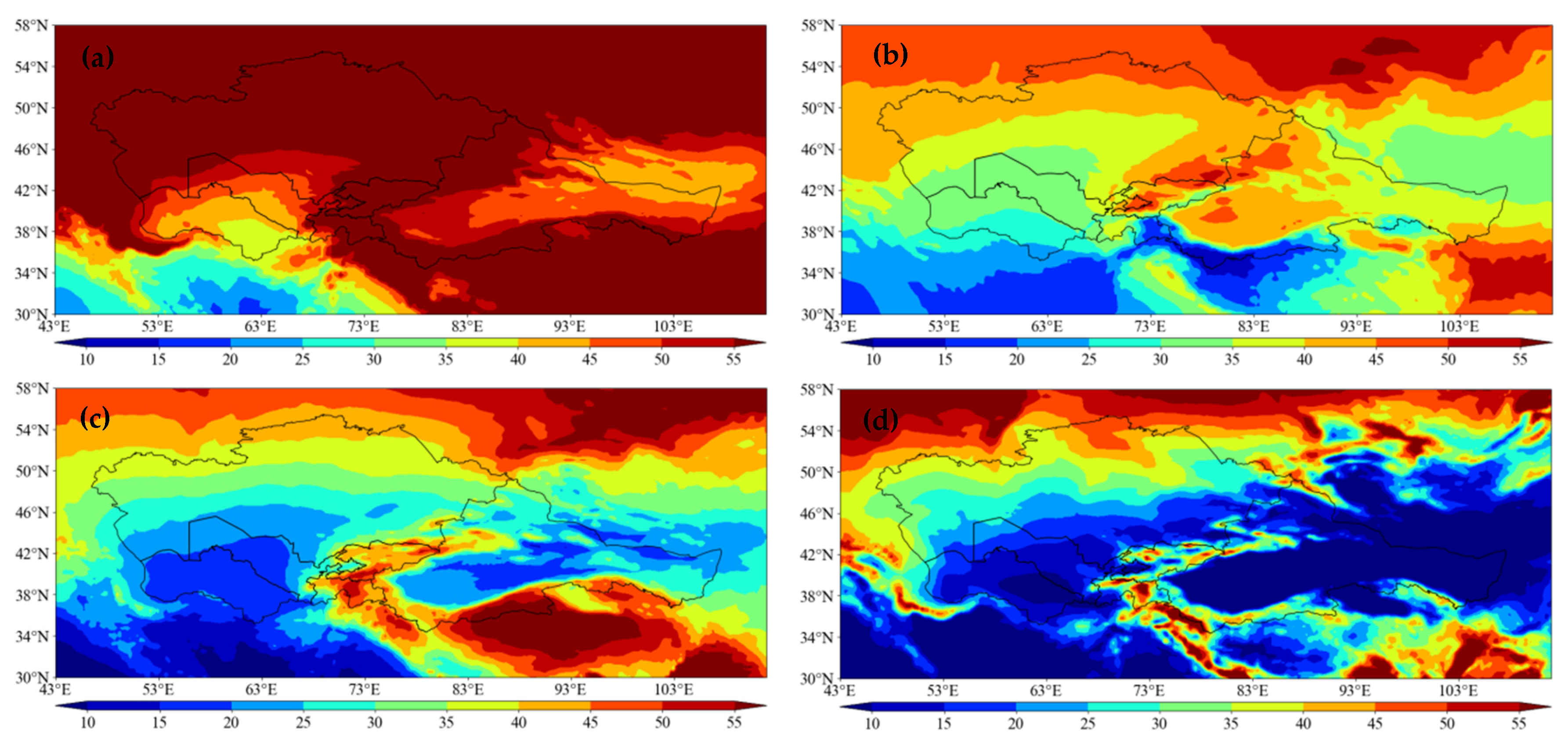
Publisher’s Note: MDPI stays neutral with regard to jurisdictional claims in published maps and institutional affiliations. |
© 2022 by the authors. Licensee MDPI, Basel, Switzerland. This article is an open access article distributed under the terms and conditions of the Creative Commons Attribution (CC BY) license (https://creativecommons.org/licenses/by/4.0/).
Share and Cite
Zhao, K.; Zhu, G.; Liu, J.; Sang, L.; Jiao, Y.; Lin, X.; Wang, L.; Liu, Y.; Xu, Y.; Zhang, W.; et al. Temporal and Spatial Distribution of Cloud Water Content in Arid Region of Central Asia. Sustainability 2022, 14, 15936. https://doi.org/10.3390/su142315936
Zhao K, Zhu G, Liu J, Sang L, Jiao Y, Lin X, Wang L, Liu Y, Xu Y, Zhang W, et al. Temporal and Spatial Distribution of Cloud Water Content in Arid Region of Central Asia. Sustainability. 2022; 14(23):15936. https://doi.org/10.3390/su142315936
Chicago/Turabian StyleZhao, Kailiang, Guofeng Zhu, Jiawei Liu, Liyuan Sang, Yinying Jiao, Xinrui Lin, Lei Wang, Yuwei Liu, Yuanxiao Xu, Wenhao Zhang, and et al. 2022. "Temporal and Spatial Distribution of Cloud Water Content in Arid Region of Central Asia" Sustainability 14, no. 23: 15936. https://doi.org/10.3390/su142315936
APA StyleZhao, K., Zhu, G., Liu, J., Sang, L., Jiao, Y., Lin, X., Wang, L., Liu, Y., Xu, Y., Zhang, W., & Ye, L. (2022). Temporal and Spatial Distribution of Cloud Water Content in Arid Region of Central Asia. Sustainability, 14(23), 15936. https://doi.org/10.3390/su142315936




